Destination
Destination
Housing the tomb of Imam Reza (8th Imam of Shia Muslims), Mashhad is considered as a religious hub for Iranians and Shia Muslims all around the world. Each year around 30 million Iranians visit Mashhad and over 1.5 million foreign visitors go to Mashhad. Note that there are strict dress codes for women to be allowed to enter the shrine. They will be provided with Chador as well.
First things first, visit Imam Reza Holy Shrine which is one the most prominent sites for Shia Muslims; it will bring about a great chance for you to widen your horizon on Shia Muslims’ rituals and customs.

Aside from all the attractions of the Mashhad itself like Mellat Park, Darougheh Historical House, Nader Shah Afshar’s Tomb, do not miss out on amazing landscapes and natural sites of the city like Neyshabur, Shandiz Complex, Torghabeh, and Zoshk Village. Shandiz Complex is a huge recreational hub that offers a wide range of activities for tourists. Mashhad Water Waves Lands is also a huge water park where you can have so much fun and rest a bit.Do not forget to try the well-known Persian Kabab Shishlik at Torghabeh or Shandiz since they offer the best quality of kebab in Iran. Shole is also one of the very famous Mashhad’s local dishes that you should not miss trying. Bear in mind that Mashhad produces the best Saffron in Iran, so buying some is highly recommended.
Mashhad has harsh winters and pleasant summers. In order to have a pleasant stay, we recommend you travel there any season except for winter. Especially if you are looking to visit the nearby sites and cities surrounding Mashhad like Neyshabour city, and Zoshk, Shandiz, and Jaghargh villages since having access to these places will be hard.
![]() Karachi, Pakistan
Karachi, Pakistan
![]() Karbala, Iraq
Karbala, Iraq
![]() Kuala Lumpur, Malaysia
Kuala Lumpur, Malaysia
![]() Lahore, Pakistani province of Punjab
Lahore, Pakistani province of Punjab
![]() Afhanistan-Mazar-i-Sharif, Afghanistan province of Balkh
Afhanistan-Mazar-i-Sharif, Afghanistan province of Balkh
![]() Najaf, Iraq
Najaf, Iraq
![]() Santiago de Compostela, Santiago de Compostela is the capital of northwest Spain’s Galicia region
Santiago de Compostela, Santiago de Compostela is the capital of northwest Spain’s Galicia region
![]() Ürümqi, china the capital of the Xinjiang Uyghur Autonomous Region
Ürümqi, china the capital of the Xinjiang Uyghur Autonomous Region
30-Day Iran Visa Delivered in 3 Days
The safe solution
The freedom to explore Iran
The fastest, most reliable & efficient
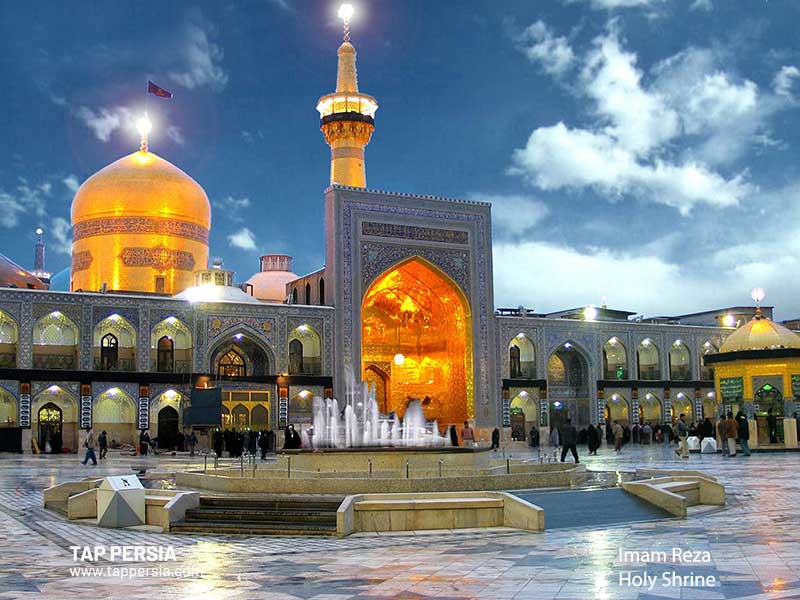
The shrine of Imam Reza (AS) is one of the most famous tourist attractions in Mashhad and Iran. Every year, millions of pilgrims from Iran and the world go to Mashhad to visit this their Imam. The shrine of Ali Ibn Musa al-Reza (AS) has been changed and developed many times throughout history.
The structures of this holy shrine date back to pre-Safavid times, and Timurids. But during the reign of Shah Tahmasb Safavid, they did a lot of work to expand the shrine. So this holy place is a large museum of Iranian architecture.
This shrine is one of the most magnificent and popular places in Iran that has many lovers. The Razavi shrine does not only include the tomb of Imam Reza. This religious complex includes several buildings and sub-complexes. The number, variety, and magnificence of these buildings and sub-complexes have made this holy shrine worldwide popular. This place is on Iran’s National Heritage List due to its historical, artistic, and architectural values, in addition to its spiritual values.
The tomb of Sheikh Bahai, a prominent scientist of the tenth and eleventh centuries AH, is located inside the holy shrine of Razavi. You can find it after the portico of Imam Khomeini with a stone tomb and a glass cover. The tomb of this scientist before his death was also his teaching place. This place has an area of about 102 meters, which is decorated with many mirrors and calligraphic inscriptions. The date of his birth and death is engraved on the wall inscriptions of this tomb.
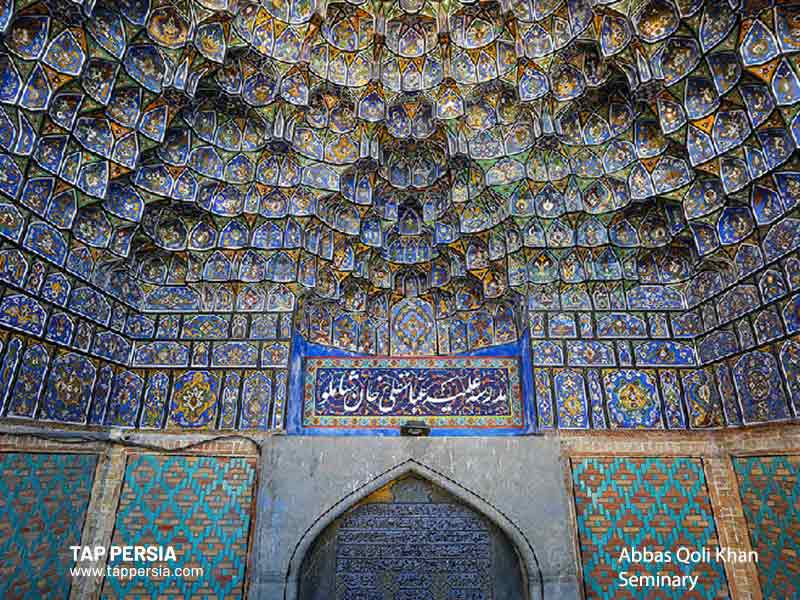 Abbas Qoli Khan Beglarbegi built Abbas Qoli Khan Shamloo Theological School by the orders of Shah Suleiman the Safavid in 1666. You can visit this school, which is on Iran’s National Heritage List, at the beginning of Safavid Street.
Abbas Qoli Khan Beglarbegi built Abbas Qoli Khan Shamloo Theological School by the orders of Shah Suleiman the Safavid in 1666. You can visit this school, which is on Iran’s National Heritage List, at the beginning of Safavid Street.
This place is currently a seminary. The school building has two floors and four sides with four Iwans in the style of Safavid architecture. This building has more than 100 rooms. The building is made of bricks and has decorations such as tiling and muqarnas at the entrance of rooms and porches.
The green dome is the tomb of Sheikh Momen Astarabadi, which dates back to the Safavid era. The plan of the green dome is octagonal and has four Iwans. In addition to the Iwans and arches, its beautiful tiling has given a special effect to the tomb. You can visit this historical monument in Akhund Khorasani Street, in the middle of the square of the same name. Shah Abbas was the person who ordered to build the Green Dome. And Not it is on Iran’s National Heritage List.
The tomb of Pir Palandouz belongs to Mohammad Aref Abbasi, one of the great mystics of the tenth century AH. They built this nationally registered tomb during the Safavid period. This is a quadrangular monument with an onion-shaped dome and a beautiful brick Iwan. Inside the tomb, there are remnants of paintings from the Safavid period on the ceilings. It is decorated with simple colored turquoise tiles. They built the original building during the reign of Sultan Mohammad Khodabandeh and then Astan Quds rebuilt in recent years.

In the middle of a lush garden, 20 km north of Mashhad, the tomb of Abolghasem Ferdowsi Tousi lies. The current building of the Ferdowsi Tomb and Toos Museum reflects the Achaemenid architecture, especially the tomb of Cyrus. Iran’s National Heritage Association started constructing this building in 1964. And they completed it in 1968 under the supervision of Engineer Houshang Seyhoun.
The exterior of the building includes Achaemenid decorative elements, especially the columns and capitals. Additionally, the poems written on the four sides of the building belong to Hakim Ferdowsi, the great writer of “Shahnameh“. And these poems represent his thoughts and personality. Moreover, in some parts of the tomb, there are some murals that show scenes from the narrations of Shahnameh.
The Haftad-o-do Tan Mosque or Shah Mosque is located on Khosravi Street, at the beginning of the Grand Bazaar. This historical building was originally a tomb which later was turned into the current building of the mosque. The building consists of a four-arched dome, two broken minarets, and an Iwan. Shah Mosque is on Iran’s National Heritage List, as well.
On the south of Imam Reza shrine, you can find Goharshad Mosque. They built this mosque by the order of Goharshad (Gawhar Shad), Shahrokh’s wife. And it is one of the most visited and crowded mosques in Iran.
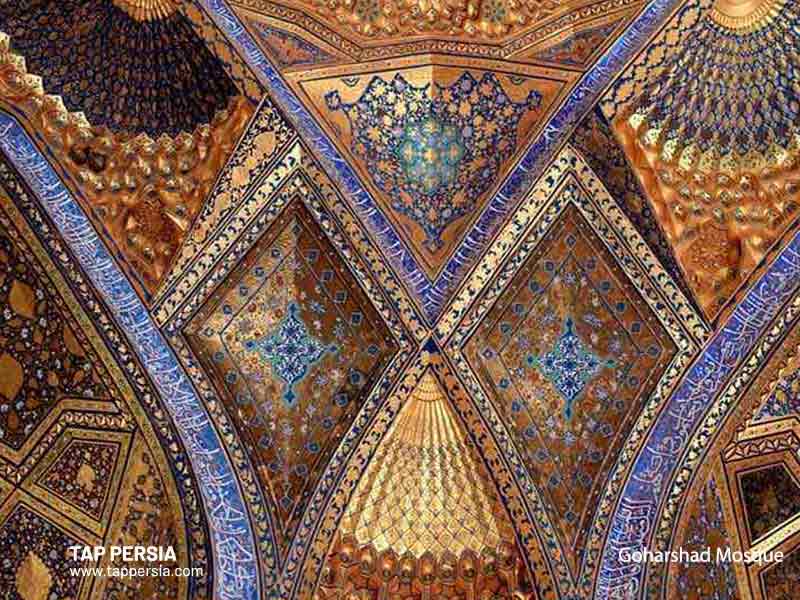 The architecture and tiles of this mosque are famous and attract many tourists
The architecture and tiles of this mosque are famous and attract many tourists
Saint Mesrop Armenian Church is the only church in Mashhad. Armenians who lived in Mashhad built this church in the Dahom-e Dey Square. The building dates back to the first Pahlavi period. Additionally, the plan of the church building is almost trapezoidal in shape.
This building has two conical domes with a cross at the top of both of these cones which is one of the prominent and unique features of this building. The larger dome is located in the middle of the building and the cross installed on top of it is made of iron; At the bottom of the dome, there is a row of white tiles patterned with green mud.
You can find Bazaar Reza at a short distance from the holy shrine. It is one of the busiest and most visited traditional bazaars in the country. In addition to its beautiful and traditional architecture, this bazaar is one of the oldest centers for offering souvenirs and handicrafts in Mashhad.
Bazeh Hoor Chahartaqi is known as the oldest Chahartaqi in Iran which some say dates back to the Parthian era. However, a study of the history of Iranian architecture shows that Chahartaqi is usually the architectural style of the Sassanid period. And according to archaeologists, the building was used in the Sassanid period. Anyway, they are not yet sure whether the building was a fire temple or anything else.
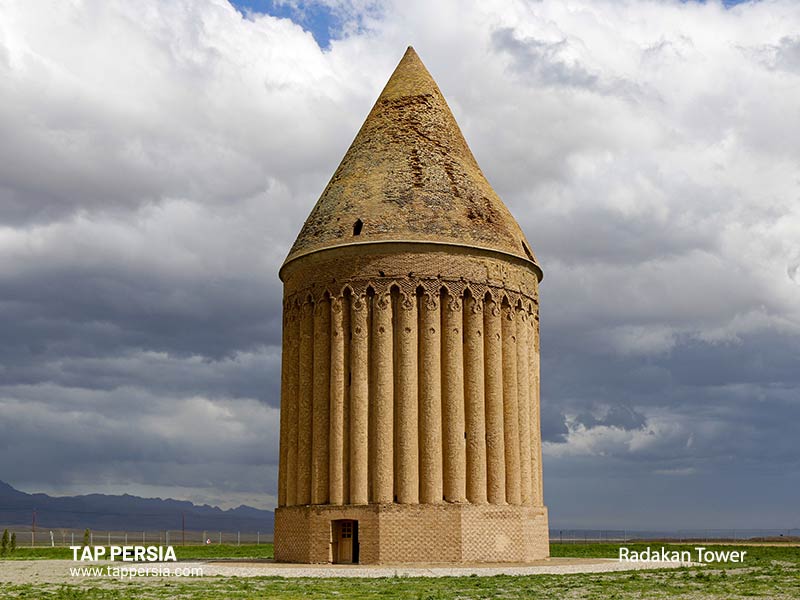
The height of Radkan tower is about 25 meters. The tower has a cylindrical body and its dome is conical. This historical monument belongs to the Ilkhanid period and the seventh century AH. The exterior of this building is 12-sided up to three meters high. And then up to the dome has 36 cracks or half-cylinders. But inside the building is octagonal.
The tomb of Khajeh Abaslat is the burial place of one of the closest companions of Imam Reza (AS). You can find it on the road from Mashhad to Fariman. The main building of the tomb is quadrangular and has four doors. The seven-color tile decorations, two rectangular porches, and the mirror works of this building are beautiful and spectacular. The shrine of Khajeh Abaslat is one of the places that most pilgrims of Imam Reza (AS) go to pay their respects.
Akhangan Rod is in fact the burial place of a person with an unknown identity. Some believe that the female motifs on the tower indicate the identity of the deceased. According to them, the buried person is Gohar Taj, Goharshad’s sister, the wife of Shahrokh Teymouri.
This is while another group attributes it to an Indian girl who was a follower of Imam Reza (AS). According to their story, she died while traveling on a pilgrimage. Others think that this building is the mass grave of important and distinguished people. But the validity of these theories has not been proven.
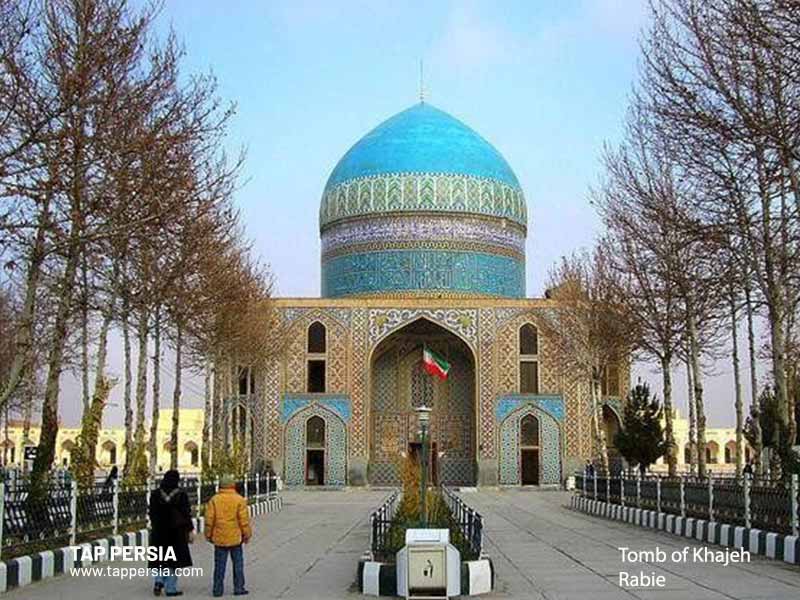
The tomb of Khajeh Rabi, which dates back to the Safavid period, is one of the sights of Mashhad at the end of Khajeh Rabi Street. They built this building on the advice of Sheikh Baha’i by the order of Shah Abbas Safavid. This tomb is on Iran’s National Heritage List, as well.
Golestan Dam is one of the historical dams of Khorasan province, the basis of which dates back to the Timurid period. You can visit this dam eight kilometers west of the city on the Golestan River. This section is one of the tourist and scenic areas of the city. Although it is about 500 years old, it is still intact.
Malek Historical House belongs to the late Qajar period. On the eastern side of Imam Street, in front of the Finance Department, you can visit this house. This building is one of the beautiful houses left from the period of architectural transfer in the late Qajar era. Today, Malek House is the center of traditional arts, cultural heritage, and tourism in Khorasan Razavi.
It is on Iran’s Heritage List, also.
Tavakoli House is one of the historical monuments of Mashhad. This historical monument has survived from the Qajar period until today. Outstanding features of this building include tiling and brickwork in its facade. Brick columns, as well as inscriptions on top of it, give this house a beautiful look.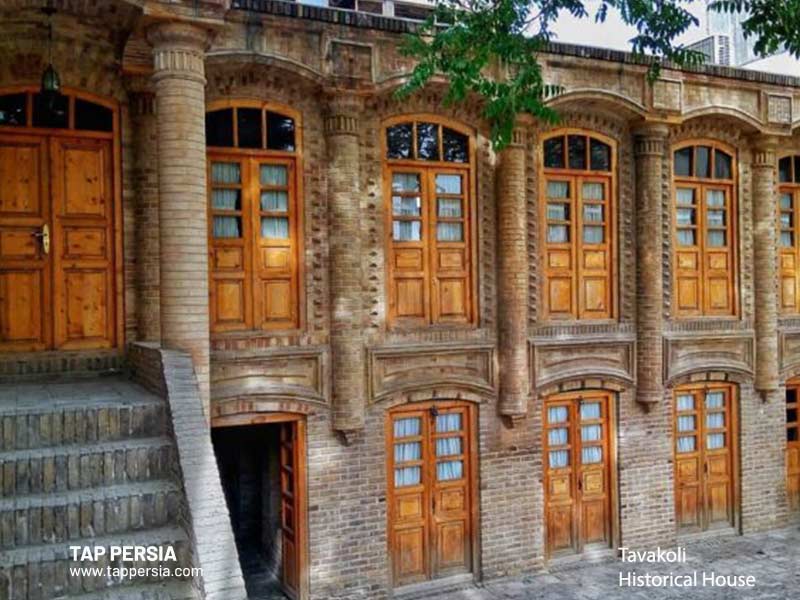
You can see numerous wooden doors, beautiful brick arches, brick columns, nested rooms, and other architectural elements of the Qajar period in Tavakoli House. They renovated this house about a decade ago. In addition to the attractive appearance of this building, they opened an anthropological museum inside the house. The museum conveys the life of the people during the Qajar period. And particularly, it focuses more on the Maktabkhaneh-s (old schools) of that time.
They built the Darogheh (Daroogheh) historical House of Mashhad, which is one of the sights of the city, in the late Qajar period. Daroogheh means Sherrif. And since the last Darogheh of the city ordered to build this house for personal accommodation and formal receptions for his guests, they call it by this name.
Daroogheh House plus the yard occupies an area of 1100 square meters. The architecture of this building is a combination of Iranian and Russian architecture. As soon as you pass the door and enter the yard, you will notice that this house is about 75 cm lower than the level of the alley. There is a beautiful pool and two small gardens in the yard that will attract your attention for sure.
The magnificent architecture of Nader Shah’s tomb on the one hand and the Naderi Museum, on the other hand, have made this complex one of the tourist attractions of Mashhad. The architecture of the building is interesting and the museum exhibits historical and valuable objects such as old weapons.
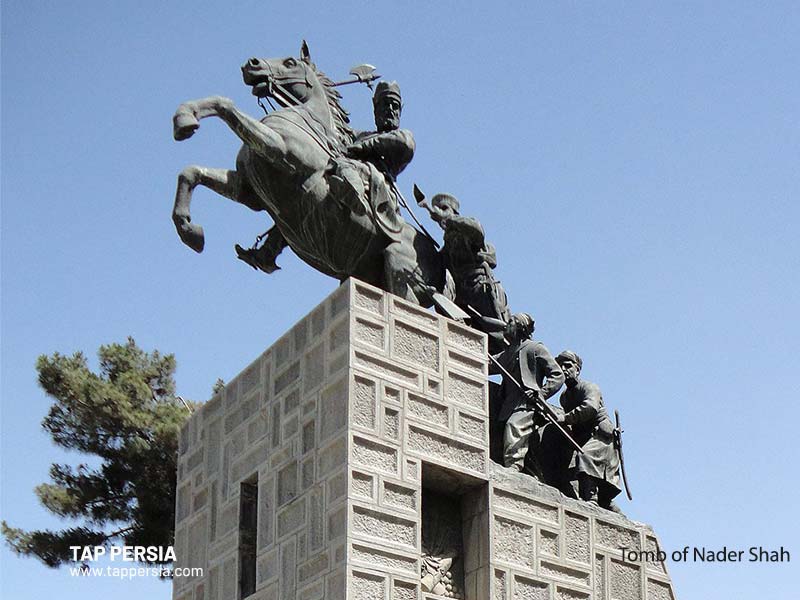 The tomb of Nader Shah Afshar is a monument they built in memory of Nader Shah in Mashhad. Ghavam al-Saltanah built a new tomb for Nader in the late Qajar period (1917). And he ordered to transfer his bones from Tehran to the new tomb in Mashhad. This small tomb was built of clay and mud, near Chaharbagh Shahi and in front of the shrine of Imam Reza (AS). He was buried there until the National Heritage Association of Iran in 1956 decided to build a suitable tomb for him in the same place as the tomb of Ghavam al-Saltanah.
The tomb of Nader Shah Afshar is a monument they built in memory of Nader Shah in Mashhad. Ghavam al-Saltanah built a new tomb for Nader in the late Qajar period (1917). And he ordered to transfer his bones from Tehran to the new tomb in Mashhad. This small tomb was built of clay and mud, near Chaharbagh Shahi and in front of the shrine of Imam Reza (AS). He was buried there until the National Heritage Association of Iran in 1956 decided to build a suitable tomb for him in the same place as the tomb of Ghavam al-Saltanah.
They built Mehdi Gholi Beyg Bath in 1648 by the order of one of the Timurid rulers. You can visit this Hamam near the Grand Bazaar of Mashhad. The bath is now a museum and represents old tools for history buffs.
Mashhad Botanical Garden includes various sections such as a rose garden, educational and theatrical plot, vegetation complex of Iran, arboretum and systematic plant complex, the native orchard of Iran, coniferous plant complex, rock garden and nursery complex, and reproductive greenhouses. It has 44,776 square meters of grass, 14,950 square meters of trees and shrubs, 12,300 square meters of hedges, 25,252 square meters of permanent flowers, 9,500 square meters of seasonal flowers, and 68,200 square meters of walkways.
This complex has several collections such as a collection of rock gardens, a collection of medicinal and aromatic plants, a collection of nurseries and production greenhouses, a permanent chrysanthemum festival, a rose garden, a garden of native Iranian fruits, a systematic and arboretum section, a plant seed section, genome bank, and so on.
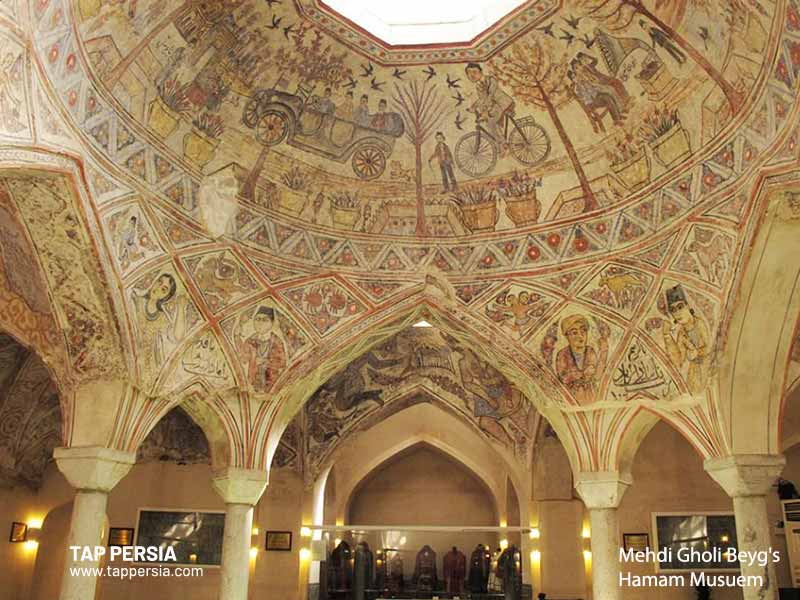
The Bread Museum is the first bread museum in the country. It displays all the processes and tools related to bread, from planting and harvesting to baking different types of bread, all of which are derived from Iranian culture.
The Museum of Astan Quds Razavi is one of the most important sights in Mashhad. It has 11 treasure museums such as; the Treasure of Razavi shrine history, Stamp and postal history Treasures, Banknote Treasure, Coin Treasure, Aquatic Treasure, Astronomy Treasure, Clock Treasure, Weapons Treasure, Treasure of dishes, Medal treasure, Treasures of Visual Arts…
The museum building has four floors, including the basement, ground floor, first and second which accommodate all valuable cultural items in it.
Pahlavani and Zurkhaneh traditions are among the traditional customs of Iran, which are on the UNESCO World Heritage List as well. Murshid Ali Akbar Ghasemi, known as Pahlavan Rostam was the one who built the Museum of Pahlavani Rituals or the Shah Lafata Museum in 2005. And he did all the designing, architecture, carpentry, forging, decorating, and collecting of objects for this museum.
Anthropology Museum of Mashhad, former Mehdi Gholi Beyk Bath or Shah Bath, is one of the tourist attractions of Mashhad and belongs to the Safavid period. This building is one of the largest baths in Iran, which has a very beautiful structure of old baths. The main structure of the building is brick and lime, mortar, stone, glass, metal, and tiles. This Hamam is a collection of various spaces. The largest and most beautiful part of it has eight columns and painted decorations.
Today this hammam is an Anthropology Museum that displays items people used to take a bath in the past. It is on Iran’s National Heritage List, as well.
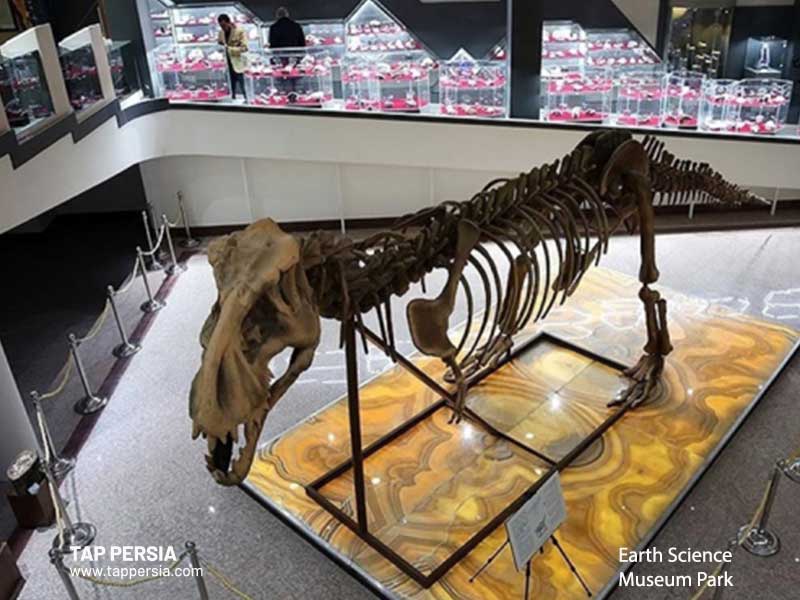 Mashhad Earth Science Museum Park is one of the fascinating museums and sights of Mashhad. The Museum of Earth Sciences has collected amazing specimens of various rocks, minerals, and fossils from all over Iran and the world. Other interesting sections of the museum include the outdoor area which has a solar system model, sundials, dinosaurs, and so on.
Mashhad Earth Science Museum Park is one of the fascinating museums and sights of Mashhad. The Museum of Earth Sciences has collected amazing specimens of various rocks, minerals, and fossils from all over Iran and the world. Other interesting sections of the museum include the outdoor area which has a solar system model, sundials, dinosaurs, and so on.
The Great Museum of Khorasan is one of the most interesting places in Mashhad, with an infrastructure of nearly 18,000 square meters. You can visit it in the cultural and entertainment complex of Kuhsangi. The building has 12 floors and 6 sections (museum hall, exhibition hall and museum, specialized library, meeting hall, laboratory for protection and restoration of historical objects and historical decorations, storage tank for historical movable objects and architectural decorations).
Curious about the entrance fees for Iran’s historical places ? Find out in this post!
Vakilabad Zoo, in Vakilabad Forest Park, is the only zoo in Mashhad and Khorasan Razavi province. There are a variety of carnivorous, herbivorous, aquatic animals, and birds in this collection. Half of the animals in the zoo are native and the other half are non-native. There are also two separate sections with separate entrance tickets at the Vakil Abad Zoo. one for taxidermy animals and the other for reptiles such as lizards, crocodiles, and snakes.
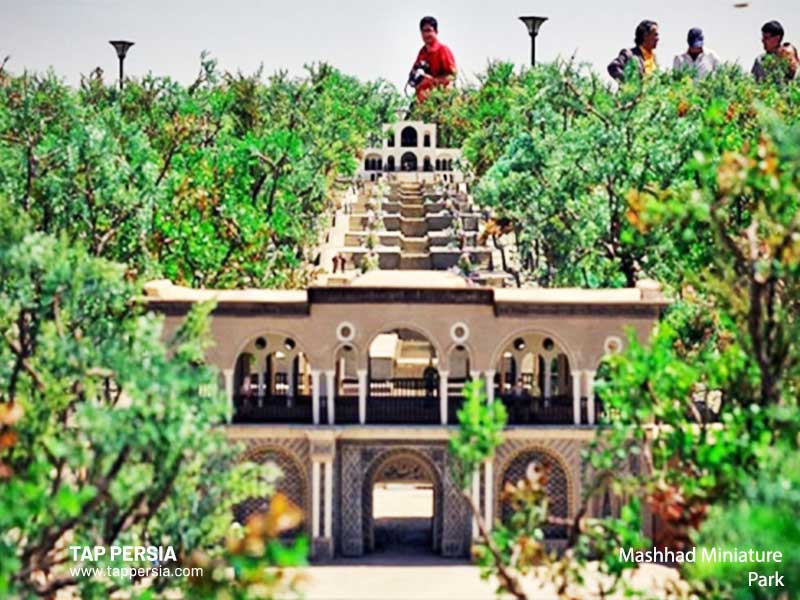
Mashhad Miniature Park includes an eight-hectare plot of land. They opened this park in order to develop green space, boost tourism, display important historical places in different parts of the country to people, represent the local culture of the city, and create a suitable space for leisure.
This park, in addition to historical and cultural models and elements, also has many recreational facilities. It has a lake with an area of 2,095 square meters and a river with a length of 216 meters. There is also a 920-meter-long train that tourists can use to go around and see the miniature structures(Iran destinations).
Chalidarreh is one of the tourist attractions around the city of Mashhad. They built Chalidarreh Dam Lake to irrigate the gardens around Torqabeh. This place has recreational facilities such as boating, fishing, and a restaurant, as well. Jaghargh River supplies the water behind the dam.
Kuhsangi or Kooh Sangi Park is the second-largest park after Mellat Park) in Mashhad. You can find this park southwest of Mashhad and at the end of Kuhsangi Street. Kooh Sangi Park is located on the edge of high mountains and is one of the oldest villages in Mashhad.
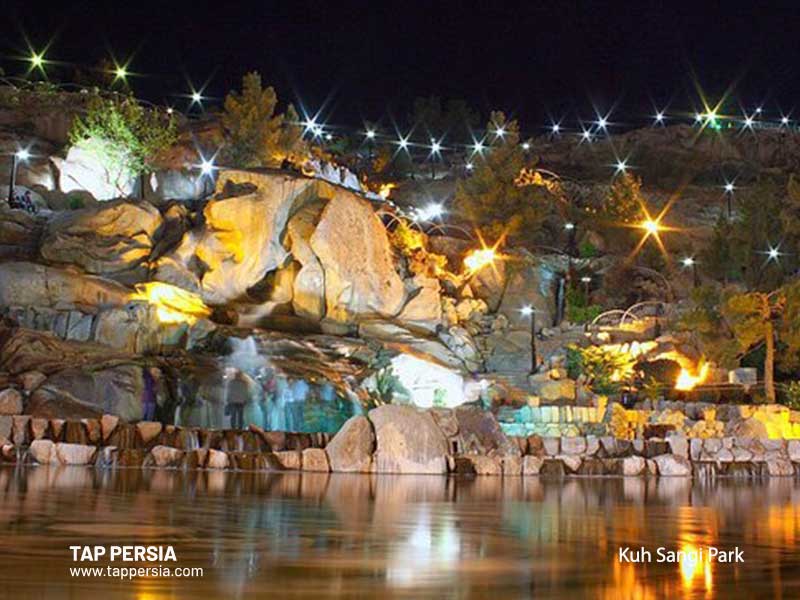 This place is one of the oldest and most famous parks in Mashhad and is one of the most beautiful parks built in Iran. This park is a combination of water, stone, greenery, and light. In 1961, with the expansion of the city of Mashhad, Kuhsangi connected to the main body of the city. With the development plans of Mashhad, Kuh-e-Sangi Park became a popular tourist entertainment complex.
This place is one of the oldest and most famous parks in Mashhad and is one of the most beautiful parks built in Iran. This park is a combination of water, stone, greenery, and light. In 1961, with the expansion of the city of Mashhad, Kuhsangi connected to the main body of the city. With the development plans of Mashhad, Kuh-e-Sangi Park became a popular tourist entertainment complex.
The National Park is now one of the largest and cleanest parks with a fountain and tall trees. It has become a beautiful and special place in the hustle and bustle of the city center. In the past, the area of the National Garden was more than 40,000 square meters. However, there were some interventions. Therefore, the area of the National Garden today is about 26,000 square meters.
The lush plane and poplar trees, along with the fountains and flowerbeds, have created a very pleasant and clean atmosphere; Surely those who are tired of the hustle and bustle of the city can relax in this park and catch their breath.
Vakilabad Park is one of the old and beautiful promenades of Mashhad, in the southwest of Mashhad, at the end of Vakilabad Boulevard. This forest park, formerly known as Mirtaraz or Vakilabad Garden, was officially dedicated to public use by its owner. Vakilabad Zoo is the only zoo in Mashhad. And it is next to Vakilabad Forest Park.
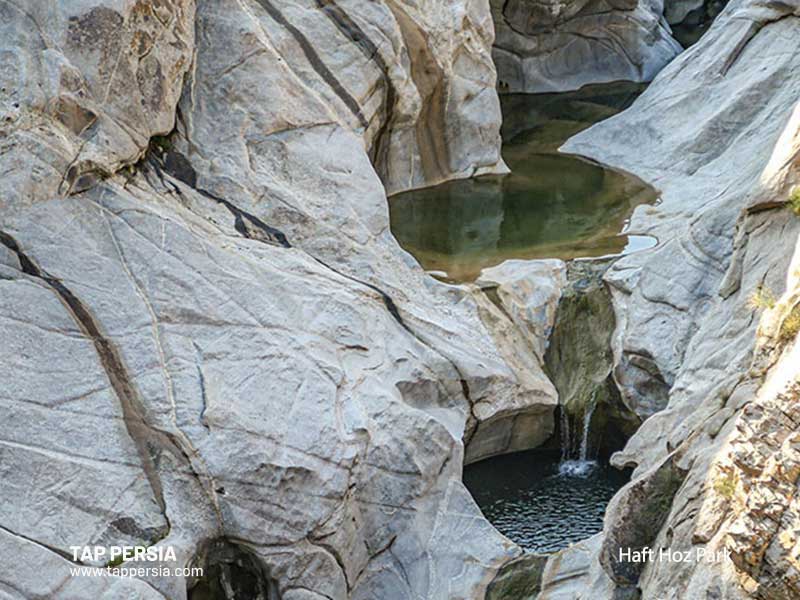
Haft Houz or Seven Pools is one of the most beautiful natural attractions of Mashhad, in the heart of the Khalaj Mountains. Some of these pools are smaller than others. After passing through these seven pools, the water flows into a larger pool and the river continues its course. Anyway, This area is about seven kilometers away from Mashhad and includes seven natural pools.
Professor Bazima Science Park is the first theme park in Iran. This park is an area of about 2400 meters on the fourth floor of the Vesal complex, in the Sepad tourist area of Mashhad. Professor Bazima Science Park consists of various sections of the creation tunnel, games, and shops that take you inside the body, into outer space, flying over the sky, and other strange events of life.
Unfortunately, it has been closed for a while so if you are planning to visit this place make sure it is open.
Mashhad has a unique position in the field of construction of water parks in the Middle East. One of the special sports attractions in Mashhad is the indoor water parks that are available all year round. Iranian Water Park, Water Waves Land, Aftab Shore Park, and Mojhaye Khorushan Water Park are the most equipped and popular water parks in Iran.
Mellat Park is one of the sights of Mashhad and one of the oldest parks in the city. The area of this park is 720,000 square meters (72 hectares). Furthermore, there are more than 35,000 old trees from several decades in this beautiful park. There is also a lake on the east side of the park and an amusement park which includes the central part to the eastern parts of the place.
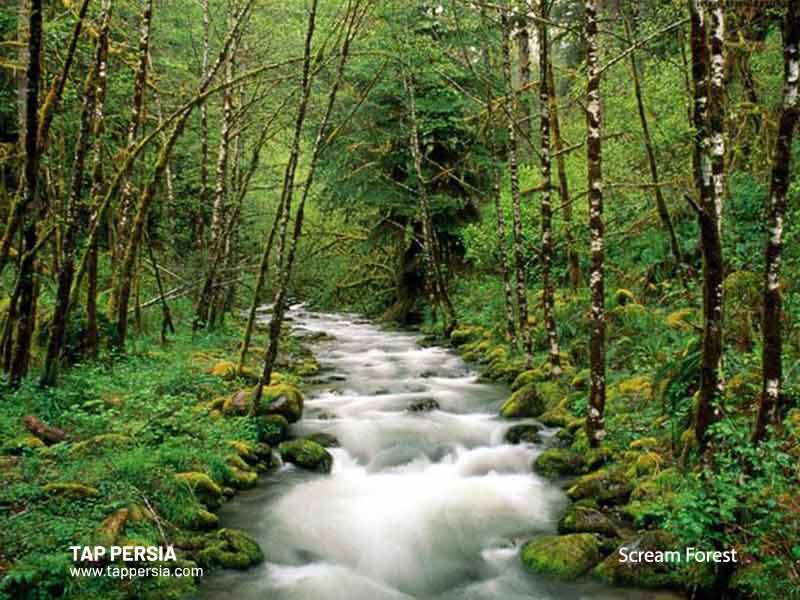 Scream Forest is one of the scariest forests in Iran and one of the sights of Mashhad. This place attracts tourists to Sarbarj village every year. The name of this forest makes everyone curious and everyone wants to find out the secret of this forest. Mashhad Scream Forest is a cursed forest based on local stories and is home to goblins and demons.
Scream Forest is one of the scariest forests in Iran and one of the sights of Mashhad. This place attracts tourists to Sarbarj village every year. The name of this forest makes everyone curious and everyone wants to find out the secret of this forest. Mashhad Scream Forest is a cursed forest based on local stories and is home to goblins and demons.
Everyone who has visited this forest confirms these screaming and strange sounds. Another scary thing about this forest is that the sound of screams only starts by the time it gets dark. Otherwise, this forest is no different from other ordinary forests during the day.
The city of Torqabeh is one of the best and most famous recreational and tourist attractions in Mashhad. In addition to travelers, many local people from Mashhad also visit this beautiful mountainous region during the holidays. Torqabeh has a variety of restaurants with high-quality food that can satisfy you to a great extent. These restaurants have made significant progress after Torghabeh became a tourist attraction. By visiting this place not only can you enjoy the delicious food but also you can enjoy the fresh air, beautiful nature, and landscaping o the restaurants.
In Binaloud mountains, two kilometers from Akhlamad village, there is Akhlamad Waterfall. This waterfall is several thousand years old. At the beginning of the valley, there is a variety of beautiful flowers and plants and dense trees. Then you get to the first waterfall, which is 23 meters high. After passing by this waterfall, about one kilometer away, you get to the main waterfall of Akhlamad with a height of about 40 meters. It is one of the tallest waterfalls in Iran.
Inverted houses have become one of the newest tourist attractions around the world. These spaces with a new style of architecture and layout, evoke the feeling in the visitor that he is in an upside-down house. Almas Inverted House in Mashhad is one of these examples. In addition to visiting, photography is one of the most important pastimes everyone loves in this house. You should not miss visiting this place.

Kardeh Dam is a concrete dam with 36 million cubic meters of water. This area, which is one of the sights of Mashhad, is located at the end of Khajeh Rabi Street in a pleasant area. Besides the Kardeh River, beautiful mountain scenery, and the water world recreation complex on the shore of the dam, this area is one of the water promenades of the city.
The water of Kalat waterfall which originates from a spring a few kilometers above the waterfall is significantly warm. Not hot enough to be considered a hot spring, but it is probably around 30 to 35 degrees. The warm waterfall and its pond are extremely suitable for watering.
Moghan Cave is one of the sights of Mashhad, 27 km from the city, south of Moghan village. Based on the available evidence and the discovery of cochlear fossils in the paths leading to the cave, they assume this phenomenon belongs to one hundred million years ago or the second geological period. Despite its glory, due to dangerous precipices in Moghan cave, entering it without the necessary guidance and tools is dangerous.
You may be wondering what the word Garab or Garaab means. The answer of linguists and historians to this question is that Garab refers to those springs and mineral waters that have sulfur compounds. Garab spring is not just a spring, but a collection of several springs on different hills. These springs, which are about 500 meters apart, have conical openings and are located at a higher altitude.
But the amazing thing about these springs is that each of them has a different color and taste. And it is all due to the certain minerals in each. Because of these substances, they have one of these tastes; sour, bitter, or salty.
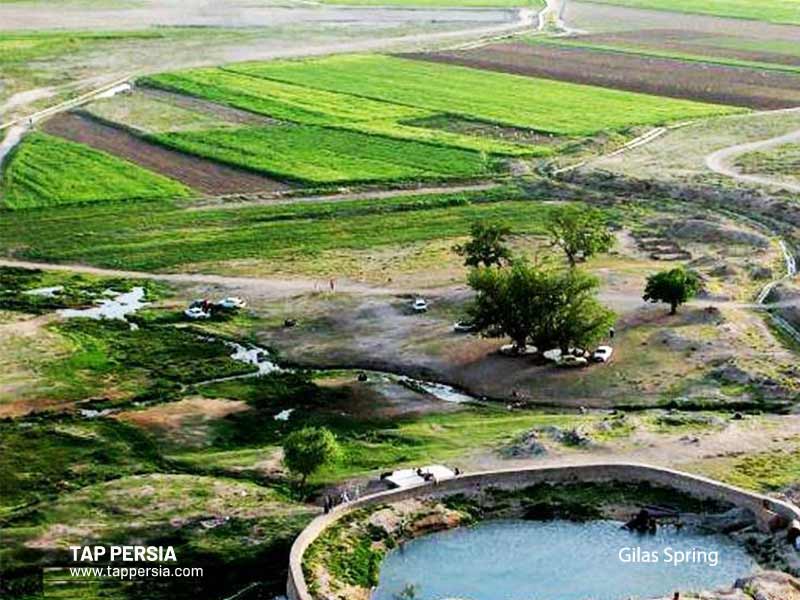 Gilas spring, which is one of the tourist attractions of Khorasan Razavi province, is more than a thousand meters above sea level. It has a depth of four to five meters and its flow rate is about 230 liters per second. The experts this spring in the group of limestone springs.
Gilas spring, which is one of the tourist attractions of Khorasan Razavi province, is more than a thousand meters above sea level. It has a depth of four to five meters and its flow rate is about 230 liters per second. The experts this spring in the group of limestone springs.
Gilas spring has created small ponds and lakes around it. Also, the surrounding area is a popular and lovable place for nature lovers and tourists during the year, especially in summer, due to its cool, fresh climate.
Shirbad Ski Resort is one of the sights of Mashhad in Khorasan Razavi province. Due to being located on the highest peak of Khorasan province, the track is snowy in most months of the year. And its 500-hectare area has provided a suitable space for healthy recreation of young people with their families.
Haft Hoz Park or Haft Houz Valley, is one of the most beautiful natural attractions in the heart of the Khalaj Mountains. This area is about seven kilometers away from Mashhad and includes seven natural pools. After passing through these seven pools, the water flows into a larger pool and continues its course towards the river. Chemical erosion caused by acid rain has created such natural phenomena. Hiking and mountaineering are common pastimes in this area.
The tomb of the sage, Omar Khayyam, is one of the sights of Neyshabur in Khorasan Razavi province. Annually, a large number of domestic and foreign lovers and tourists visit his tomb. You can find this place in the southeast of Neishabour city, at the end of Khayyam Street.
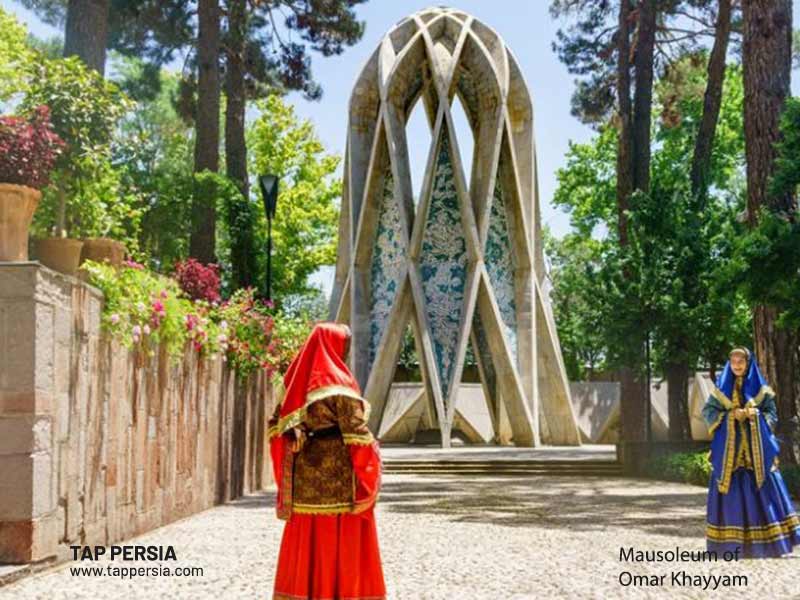 Khayyam complex, which includes a museum and tomb in a beautiful lush garden, is outstanding. Khayyam Garden has an area of 20,000 square meters with evergreen pines. And the length of the lattice monument above his tomb is 18 meters. The mausoleum is made of iron and stone in the form of a tall dome with 10 pedestals. Its pedestals are connected with geometric shapes and large and small rhombuses. Khayyam Tomb is a successful combination of traditional and modern elements of architecture.
Khayyam complex, which includes a museum and tomb in a beautiful lush garden, is outstanding. Khayyam Garden has an area of 20,000 square meters with evergreen pines. And the length of the lattice monument above his tomb is 18 meters. The mausoleum is made of iron and stone in the form of a tall dome with 10 pedestals. Its pedestals are connected with geometric shapes and large and small rhombuses. Khayyam Tomb is a successful combination of traditional and modern elements of architecture.
Attar Neyshabouri Tomb is a historical building dating back to the Timurid period which is now one of the sights of Khorasan Razavi province. Farid al-Din Attar Neyshabouri was a famous Iranian poet and mystic. His tomb on Erfan Street in present-day Neishabour city welcomes its lovers.
The tiles of the Attar dome are decorated with flowers and plants, geometric patterns, and Kufic inscriptions in green, yellow, azure, and white colors. They have built four Iwans outside of the tomb. Attar’s tombstone is black, on which there are some of his own lines written. The walls, as well, are lined with plaster and a few verses of poetry.
Mohammad Ghaffari was a prominent and famous Iranian painter. They built his tomb in the garden of “Sheikh Attar” next to the tomb of Sheikh Attar Neyshabouri. The general form of the building, along with the decorations and tiles, is very similar and harmonious to the tomb of Sheikh Attar. That’s why when entering the garden at first glance, everyone thinks that these two buildings are parts of one building. In Kamal-ol-Molk’s tomb, you can see the peak of architectural creativity in using traditional Iranian architectural elements in a new and harmonious combination.